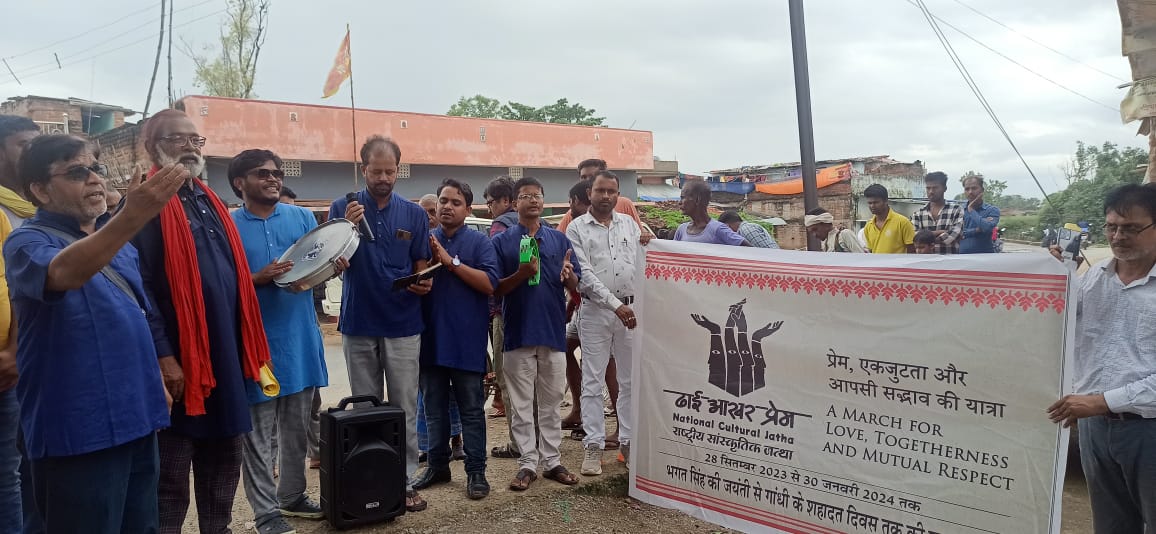हिन्दी | English | বাংলা | ಕನ್ನಡ | മലയാളം
•One day cultural walk in Garhwa, Jharkhand•
There was a slight change in the schedule of Dhai Aakhar Prem National Cultural Jatha. The reason was the threat of Nipah virus that arose in Kerala. Everyone of us has seen and faced the terrible tragedy of Covid, so it was necessary to take precautions against any such possibilities. Therefore, when the proposed procession to Kerala from October 2 to October 7 was postponed, the national leadership of IPTA decided to take out symbolic one-day yatras in different states on these dates, so that this march of love, peace, solidarity and mutual harmony does not stop, as Dhai Akhar Prem National Cultural Jatha has made the determined to spread the message of love and affection uninterrupted starting from Bhagat Singh’s birth anniversary on 28th September to Gandhi’s Martyrdom Day on 30th January, through this march in some or the other corner of India. Accordingly, in the online virtual meeting held on 22nd September, Jharkhand decided to organise a one-day symbolic walk on 5th October in Garhwa district.
In this regard, a meeting was held with the artists of Garhwa on 1st October. IPTA National Secretary Shailendra Kumar and Jharkhand IPTA General Secretary Upendra Mishra reached Garhwa and formed an organizing committee under the leadership of senior IPTA member Sanjay Tiwari. Ashrafi Chandravanshi, Yogendra Nath Choubey, Namaskar Tiwari, Virendra Ram, Zilla Parishad member Dhirendra Singh, Gautam Rishi, Rahul Singh and Anwar Jhankar of Jasam etc. took the responsibility of making the yatra successful and decided that the walk would be organised from Khajuri village to Majhiyaan.
IPTA artists from Daltonganj also decided to participate in the one-day walk in Garhwa. At 10 am, we all (Upendra Mishra, Shailendra Kumar, Prem Prakash, Rajeev Ranjan, Samaresh Singh, Anubhav Mishra, Amit Kumar Bhola, Sanjeev Thakur, Ghanshyam Kumar Sanjeet Dubey and Ravi Shankar) left for Garhwa. As soon as we started from Daltonganj, the organizers informed that there was a slight change in the program. Now the yatra will be started after garlanding the statue of Dr. Babasaheb Ambedkar at Ambedkar Chowk, Garhwa district headquarters, so they asked us to reach a little earlier than planned. Since the artists’ group were traveling in an autorickshaw, it would have taken at least one and a half to two hours to reach Garhwa and by then it would have been quite late. The artists needed to reach Garhwa first, so we exchanged vehicles. Now the group of artists had left for Garhwa in a car and the leadership team which included Shailendra Kumar and Upendra Mishra along with others were slowly catching up in an autorickshaw. But then the autorickshaw also broke down midway and they all remained stuck on the way.

Well, the group of artists had reached Garhwa. The organizers were already there waiting for all of us. The program started as soon as we reached. After paying tributes at Ambedkar Chowk, the organizers explained the objective of Dhai Aakhar Prem National Cultural Jatha and appealed to the public to join the walk. Members of Daltonganj IPTA sang the song ‘Dhaai Aakhar Prem Ke Padhne aur padhane Aaye Hain, Hum Bharat Se nafrat Ka Har Daag Mitane Aaye Hain…’ written by Omprakash Nadeem. The jatha then moved forward. While marching, we had just moved forward when the main crossroads of Garhwa was completely blocked by the local people in protest against some incident. The entire traffic and movement of people came to a half. Well, somehow we all came out of the jam and saw Shailendra ji waiting for us. He told us that since the auto by which he was coming was broken down and there was no possibility of it being repaired, everyone was stranded on the way. So they asked for a lift from a truck driver to reach Garhwa. Later it came to light that the rest of the companions would also order another vehicle from Daltonganj and reach Garhwa but there would be a lot of delay.
However, we continued the journey forward… Many more friends had joined from Garhwa, hence an auto was again booked to reach the yatra site. From Majhiyanv turn, we all boarded different vehicles and reached Khajuri village from where march was started, which went to Majhiyaan via Ataula, Kharsota. Meanwhile, there were many stops on the way where we stopped and had a dialogue with the people, shared the message of love and affection, sang songs of peace and love and distributed pamphlets among the people and moved ahead.
Historical importance of Khajuri in Garhwa to Majhiyaan via Ataula
In 1991, Garhwa district was separated from Palamu district. It is believed that the district got its name Garhwa because it is situated on low lying land. Garhwa district, adjacent to the border of Bihar, Uttar Pradesh and Chhattisgarh, is known to be an ancient trading center where during the freedom struggle, social cultural workers associated with different areas of Garhwa district undertook public awareness about the freedom struggle among the people and gave a new vision to the society.
The Lagma temple established in Khajuri village, located just 7 kilometres from the Garhwa district headquarters (where there are many temples of gods and goddesses with Mount Kailash nearby), which even today remains the center of our shared heritage. The annual Jalsa held here is the center of religious and cultural events. In which a large number of people from many nearby states visit and participate. People hold respect for Devraj Tiwari, a resident of Kokarma near Khajuri village even today. He has served the Government of India as a Senior IAS for many years after independence and shaped many development schemes at the local level and played a big role in the upliftment of the people. On reaching Khajuri village, a large group of youth was waiting for the cultural troupe, as we were 2 hours behind the schedule due to traffic jam and vehicle breakdown. A group of local youth, under the leadership of Rahul Singh, warmly welcomed the artists and others members of the troupe. These included Mohan Soni, Anil Chaudhary, Anil Kumar Yadav, Anuj Yadav, Raman Paswan, Chhotu Paswan, Manish Ram, Shyamganga etc. The youth shared information about the uniqueness of the village and its historical, cultural and religious importance. After this we all interacted with the children of the government school and told them about the objectives of the Cultural Jatha. IPTA artists presented Kabir’s song ‘Zara Dheere Gaadi Hanko Mere Ram Gaadi Wale…..’ and then moved towards the next destination.


We reached Ataula village, whose name is synonymous to revolution, midway during the walk. Palamu’s writer and journalist Prabhat Mishra Suman in his book ‘Palamu ke krantikari’ and Garhwa district’s senior litterateur Dr. Ramesh Chanchal in his book ‘Garhwa Ka Itihas’ have specially mentioned the name of Patola village. In fact, the festival of Anant Chaturdashi became popular during the 1942 revolution. The festival was celebrated with enthusiasm in this village as well. Revolutionary leader Yadunandan Tiwari, Devraj Tiwari and Inderjit Tiwari were also present in the village on Ananta Chaturdashi. The British had failed once in their attempt to capture them. The soldiers coming through the Son river were not able to reach the village because of the clever efforts from Mallah and other villagers. The policemen were distraught after this failure. When they came to know that these three revolutionaries were going to stay in the village on the occasion of Anant, they conspired to catch them by deceit. They caught them while bathing and at other places. They were first brought to the nearby police station and then sent to Daltonganj jail. After being sentenced from here, they were kept in Hazaribagh jail for a long time. Not only were all three of them relatives, another big revolutionary of the district, Jagannarayan Pathak, was also their relative. Pathak ji’s maternal home was also in Ataula. It was a very pleasant experience to visit these villages during the yatra and learn and understand about these revolutionaries and talk to the people about them.
The last stop of the one-day walk was Majhiyanv. The name Majhiyanv might have been known as a fishermen’s village. Although there is no historical evidence for this, it is merely a speculation, because Majhiyanv, situated on the banks of the Koel River, is known to be a prosperous village irrigated by the Koel River. Shambhu Nath Pravasi ji, born here, gained fame as a keen Hindi scholar and lyricist. It is important to remember Pravasi ji in this cultural jatha because during the literary tours of his time, he spent several months with Sumitranandan Pant in Allahabad and recited poetry on big platforms of the country. He used to charm everyone with his melodious songs. In the latter part of his life, he accepted Sannyasa Ashram and built Brahma Vidyalaya Ashram at Garhwa Chetan and spent the rest of his life there. His ashram is still operating. The pedestrians could not reach there due to lack of time but their message dure did.

Ambedkar’s statue was visible at the entrance of the village. We all stooped and gathered local villagers, most of whom were women. We told them about the cultural Jatha, talked to them about their opinion and the current situation. The villagers talked openly about their children’s education, health and other problems. Everyone understood that love is eternal and without love neither life nor society is possible. Be it Hindu or Muslim, Brahmin or Dalit, if there is love among all, only then we could say that we are all one. People accepted that love still exists among the people in the village. There are some people who want to spread hatred, want to make us fight among ourselves, these people need to learn the lesson of love.
At the end, a public meeting was held in Majhiyaan main market, where the members of the Jatha like Sanjay Tiwari, Ashrafi Chandravanshi, Dharmendra Singh, Rahul Singh, Shailendra Kumar and Prem Prakash etc. shared their experiences and explained the need of love to win over the growing hatred in the society. In the present era, they appealed to people to identify those who create hatred, violence and animosity among people through the politics of hatred and develop a culture of love, non-violence and harmony against them, so that we can create a better and beautiful world for all. This cultural jatha is also an attempt to do the same, where we all have come together to read and study Dhai Akhar Prem (Vocabulary/Letters/Alphabets of love), to erase every stain of hatred from India.
Report: Ravishankar | Translation: Talha Sheikh

